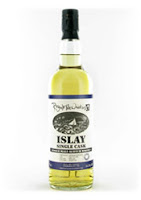 High peat level
High peat levelToday sees the release of Supernova SN2010 - the eagerly awaited new bottling from the Ardbeg distillery on the island of Islay. The whisky world has been waiting for the general release of this scotch malt ever since the first and second bottlings came out last year (the first was just for the members of the Ardbeg Committee and the second went on a general but limited release). Supernova is touted as being one of the smokiest whiskies ever produced and has a peating level of over 100ppm (phenols per million - the measurement used to calculate the level of smokiness in whisky). Compare this to the regular Ardbeg 10 years old and Laphroaig 10 years old, which have peat levels of just over 50ppm and are regarded as two of the smokiest whiskies on the market.
A cult distillery
Ardbeg is a distillery on the western Scottish island of Islay (pronounced eye-la), which is the home of the smoky style of whisky. It is located in the south east of the island and produces some of the peatiest, smokiest whiskies in the world. Ardbeg was founded in 1815 by John MacDougall, although records show that a distillery was operating on the site since 1794. The current owners are drinks company Moet Hennessey and the distillery has a capacity of approximately one million litres per year. Most of the whisky produced is released as single malt, although Ardbeg also appears through independent bottling companies, although these are becoming rarer, and has a cult following of whisky drinkers across the world.
For more information on how peat influences whisky and how phenol levels are calculated, then read Explain about ... Peat. For more information and facts on Ardbeg, then you can also visit their distillery profile page on our website - whiskyforeveryone.com.
What's the difference?
This 2010 version of Ardbeg Supernova has the same peating phenol level of the previous two 2009 releases at over 100ppm. It is also said to be roughly the same age, although this age is not stated. The main difference is that SN2010 is bottled at a higher alcohol strength of 60.1% ABV, compared to the others which were released at 58.9% ABV. A bottle can be purchased from www.ardbeg.com from today (31 May) for £80. This is said by the distillery to have altered and deepened the aromas and flavours. Let's see, shall we ...
Our tasting notes
The colour of our sample of SN2010 is a pale gold and the nose is vibrant, fresh and packed with character. However, it is not as potent as expected when considering the high level of peatiness and the high ABV. There is obvious peat smoke that has a fresh, damp earthy note to it and this combines with strong tar, which gives it an acrid feeling. Underneath these are other notes of sweet vanilla, burnt cereal grains, fresh green fruit (think of apples), something vegetal (reminiscent of hay or compost) and a distinct saltiness. On the palate, this is again vibrant and the smokiness seems far less earthy and peaty than expected - it has more elements of coal smoke and acrid tar to it. The smokiness is backed up by a complex mix of other notes that fight for attention - vanilla, honey, damp oak, a salty brine-like tang, lemon zest, honey, dark treacle, plenty of spicy hot red chilli and hints of cocoa powder and menthol. It seems that something different comes through with each new sip! The finish is incredibly long (we tested the length and got to about 20 minutes before it properly faded) - it begins with a short sharp hit of sweetness before becoming dry, woody and hot with red chilli spice. This spiciness and woodiness increases with time, as it becomes drier and drier.
What's the verdict?
This whisky is punchy and challenging. It is intense, full on, vibrant and explodes, especially on the palate and finish, giving your tastebuds a kick where it hurts. SN2010 oozes individuality, is well made but obviously young and fresh. It is not an easy drinker and not one for every day sipping, but an occasional 'special' dram. More intense and complex than the 2009 versions, this is one for the insanest of peat heads and must be tried to be believed.

















